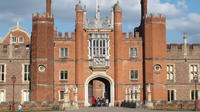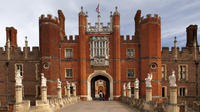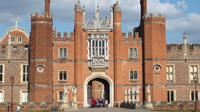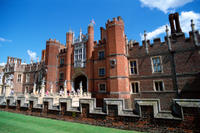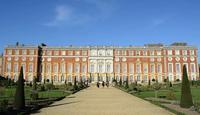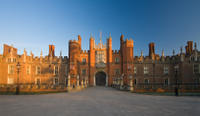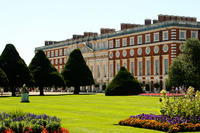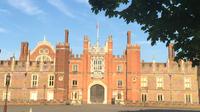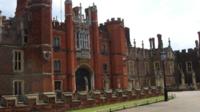Hampton Court Palace ★☆☆
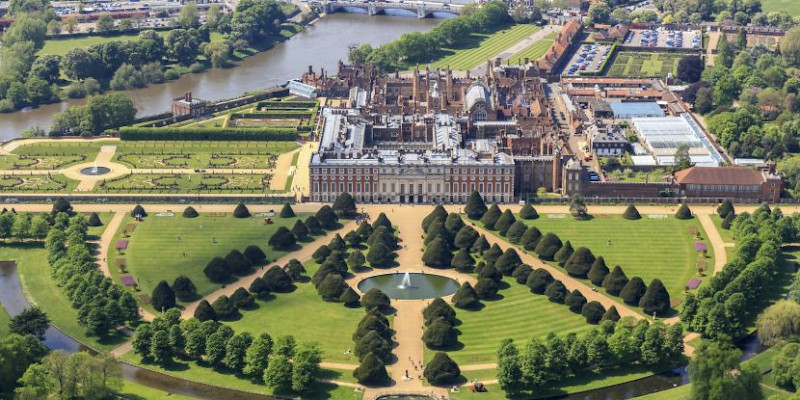
The royal palace so nice Henry VIII honeymooned here twice—and then three times, and four, and five...
What began as a 13th century farm for the Crusader order of the Knights Hospitalers of St. John was later rented to courtiers.
Cardinal Wolsey acquired it, and the favors of King Henry VIII—for a while. Wolsey was the king's chief minister and closest advisor right up until he refused to help Henry get a divorce from Katherine of Aragon (Henry's first wife).
Between that betrayal, and the fact that he lived a life here that was more extravagant than the king's, Henry VIII eventually took Hampton Court (and another Wolsey palace at York) from the now-disgraced Cardinal.
Henry VIII spent the modern equivalent of £18 million ($35 million) expanding Hampton Court in the 1520 and 30s into the vast Tudor pile we know and love today. It was built in a harmonious blend of late Perpendicular Gothic and early Renaissance styles, partly expanded yet again in a baroque style by William III, with magnificent grounds and sumptuous royal apartments, banqueting halls, kitchens, and chapels.
William and Mary hired Renaissance master architect Christopher Wren to redo the east and south facades in 1689–1700.
The last king to use it as a residence was George II.
Queen Victoria fixed the place up and opened Hampton Court to the public in 1838.
The Royal Apartments and Great Hall
Much of the palace is given over to interpreting the life and times of its most famous resident, King Henry VIII. Highlights include The Chapel Royal, with its sumptuous ceiling and modern replica of Henry VIII's crown (recreated in 2007–12 using period tools and materials based on its appearance in period paintings; the original was disassembled and melted down by Oliver Cromwell in 1649).
Under the hammer-beamed roof of Henry VIII's tapestry-spangled Great Hall, during the Christmas season of 1603–04, Shakespeare and his theatrical troupe known as "The King's Men" preformed for the court of King James I.
Not that Hampton Court is all-Tudor-all-the-time.
Charles I's agent Daniel Nys went on a buying spree in Italy in 1629, shipping home tons of Renaissance master paintings that now make up the core of the Royal Collection. Many of these are now the pride of the palace's Cumberland Gallery (see below), but the amazing The Triumphs of Caesar (1485–1506), a cycle of nine large canvases painted by Andrea Mantegna for Duke Francesco II Gonzaga, are displayed in the Lower Orangery, which recreates the room in which they originally hung in Mantova.
Then there are the 17th century State Apartments of William III, filled with ornate carved wood and paintings by Verrio, many on the theme of "William the Protestant Ousted Those Nasty Catholic Pretenders and Now All Is Well Again in Britain." (Not an official title, but might as well be.) In William III's private apartments, the paintings were hung in ropes so he could swap them around with ease. All those on display were known favorites toward the end of his life, and are hung as they would have been around the year 1700.
The Kitchens
The Tudor-era kitchens were designed to feed 600 at a single sitting—they went through 1,240 oxen, 8.200 sheep, 2,330 deer, 760 calves, 1,870 pigs, 53 wild boar, and 600,000 gallons of beer each year. It remains in operation (at least at the height of tourist season), roasting meat by the open fire from April through August.
The Georgian royal Chocolate Kitchen, built in 1689 for William and Mary, is the only one of its kind to survive in the world. It had been lost for centuries and only reopened in 2014.
The Cumberland Art Gallery
The Royal Collection—installed in the recently restored, royal-blue Georgian apartment known as Kenty's Cumberland Suite—houses works by many Old Masters, including:
- Rembrandt's Self-Portrait in a Flat Cap (1642)
- Caravaggio's A Boy Peeling Fruit (c.1592-3), a simple scene and very early work by the Italian master of chiaroscuro, playing with light and shadow.
- Artemisia Gentileschi's Self-portrait as the Allegory of Painting (c.1638-9), one of the few 17th century self-portraits of a female artist, painted by one of the few notable female artists of that era, a contemporary of Caravaggio's.
- Hans Holbein the Younger's Portrait of Sir Henry Guildford (1527), a classically insightful take on the Comptroller of Henry VIII's household.
- Hans Holbein the Younger's Portrait of Thomas Howard, Duke of Norfolk (c.1539), decked out in lynx-lined silks.
- Thomas Gainsborough's Diana and Actaeon (c1785-8), a rare mythological scene of loose brushwork that surprisingly foreshadows Cézanne and Renoir.
- Anthony van Dyck's Portrait of Mary, Princess Royal and later Princess of Orange (c.1637), the then-six-year-old daughter of Charles I. Her son, William III of Orange, would launch the "Glorious Revolution" to overthrow his mother's brother (who was also his wife's father, because that's how royalty rolls), the Catholic King James.
- Canaletto's Venice: The Grand Canal with the Scalzi and S. Simeone Piccolo (c.1726-7) by this popular 18th century master of Venetian landscapes (canalscapes?)
Also in the palace is the Mantegna Gallery, housing the The Triumphs of Caesar, nine amazing High Renaissance works by Italian master of perspective Andrea Mantegna, painted in the 1480s and brought here in 1629.
The Gardens and maze
Hampton Court's 66 acres of formal grounds contain everything from William III's Privy Garden, designed in 1702, to Britain's oldest hedge maze, created around 1700, to a 20th century garden done in a modern, informal style.
An army of 30 full-time gardeners plus another 12 specialists keep things humming.
Check out the Tiltyard Walls, angled to that various rare shrubs and plants could survive in the microclimates created by soaking them in sun or shade as required, the adjacent kitchen garden, and the Great Vine, planted by "Capability" Brown in 1768. This is counted as "the world's largest productive vine" by the Guinness Book of Records, and still producing sweet grapes (available after the early September harvest at the gift shop).
The gardens are also renowned for their daffodils, which usually peak the last two weeks of March.
Beyond the formal semicircle of plantings at the palace's east entrance stretches the 750-acre Home Park, a deer park of ponds and trees, long avenues and the descendants of the royal herd of fallow deer nibbling the grasses.
TicketsTips
Expect to spend at least two to three hours here.
Also factor in another 90 minutes total to get out here and back, as it's nearly 40 minutes from central London by public transport.
Trains (www.southwesttrains.co.uk) leave four times an hour from London's Waterloo Station to Hampton Court.
The ride takes 36–38 minutes—or 30–32 minutes it you happen to catch the express (every other train), though this requries a change at Surbiton station.
Hampton Court is the last station within Zone 6, so Oyster Card pay-as-you-go cards are valid on this train—and Oyster's daily cap for Zone 6 is cheaper than the round-trip point-to-point tickets would be, so please use it!
If, instead of a cash balance, you happen to have a 7-day Travelcard on there good only for Zone 1–2 , you will have to pay extra for this trip. Either visit the ticket office at Waterloo to get the necessary Zone 3-6 add-on tickets (£1.50 off-peak, £2.80 peak) or just top the Oyster Card off with a bit of cash to cover the full ride (£3.10 off-peak, £5.10 peak; don't worry—any unused balance gets refunded when you turn in your Oyster Card at the end of your stay in London.)
The palace is just 200 yards from the station, across a bridge.
(Alternately, you can take the District Line Tube to Richmond station then hop the R68 bus from there. However, there is little reason to do this, as it takes longer.)
Cardinal Wolsey commissioned the first Real Tennis court at the palace between 1526 and 1529, and Henry VIII kept it when he moved in.
This is not the "lawn tennis" with which you are familiar. "Real Tennis" (or "Royal Tennis") is a bit like tennis crossed with racquetball, and ricocheting the ball off the walls is part of the play. The court about half again as long as that of a lawn tennis court, and the narrow openings of the spectator's galleries serve as sort of point-scoring goals.
While the club itself remains private, the tennis pros do offer introductory lessons for non-members.More info: Royaltenniscourt.com.
Given its location outside the city, and all there is to do here, some people opt to the spend the night either right on the property of Hampton Court Palace or just across the river. Here are my picks:
- The Lion Gate Mews [££] - Nine modern, self-catering apartments sleeping 2–6 on a little courtyard right beside the Lion Gate entrance to Hampton Court Palace, at the north end of the gardens. » book
- The Kings Arms [££] - Nine traditional hotel rooms—each on an Henry VIII theme and with lovely wooden beds—in a 1709 building flanking the other side of the the Lion Gate entrance to Hampton Court Palace, at the north end of the gardens. Lovely brick-walled dining room. » book
- Georgian House Apartment [£££] - A self-catering flat sleeping eight, with a private walled garden, converted from a kitchen outbuilding built in 1718 for George I, now rented out by The Landmark Trust (4-night minimum). » book
- Carlton Mitre Hotel [££] - Thirty-six spacious, four-star hotel rooms in an 1665 structure set right on the south bank of the Thames, overlooking the river and bridge over to Hampton Court Palace. » book
Henry VIII was keen to breed the world's largest war horses, and the results were the mighty Shire Horses. (I have ridden one that belongs to my cousin Brian; they are stupefingly massive, sort of like a Clydesdale on steroids.)
The descedents of these gargantian war horses pull a tram through gardens daily from July through September, and weekends from Easter though June and again in October.


























